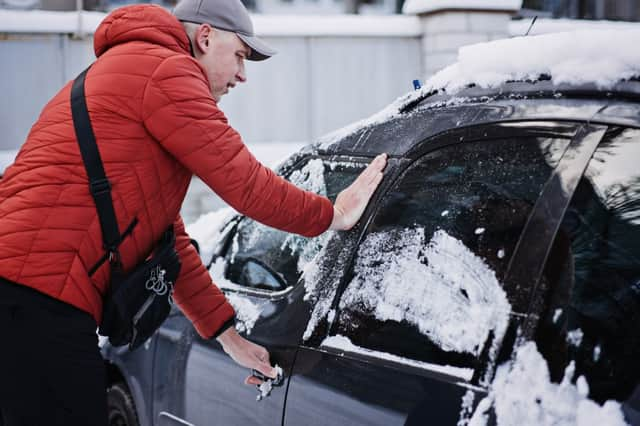Car Door Frozen: Here's what to do if your car door or lock is frozen shut - and opening it without damage


Winter is here, and along with it plunging temperatures that can lead to inconvenience for car owners.
Before you even get going, it’s likely you’ll face the usual issues of frozen windscreens (inside or out) and, more unusually, problems with doors frozen shut. Not only is this a major problem but handling it the wrong way can cause longer-lasting problems if you damage something trying to free it.
Advertisement
Hide AdAdvertisement
Hide AdA door that won’t open can be due to a number of different things, ranging from a seized handle to a frozen rubber seal or even a layer of ice sticking the door to another body panel. The solution to each problem is slightly different, as we’ll explain below, but the first piece of advice is not to just use brute force. Simply yanking on the handle when a door refuses to open is unlikely to open the door but could add to your troubles in the shape of a broken handle, ripped seal or damaged locking mechanism.
Instead follow our tips on how to free off a frozen door.
Try another door
The quickest option is to try another door. Depending on where your car is parked, one side might be more sheltered or more exposed to sunlight, making it less likely to be frozen. If you can get in another way do so then start the engine and switch on the heating. Warming the interior of the car will help thaw the frozen door.
Push, don’t pull
If your door is held shut by a thin layer of ice a firm shove might be enough to crack the ice. Put your hand flat against the door and lean with your body - you want a firm, sharp push but not a sudden slam.
Remove any surface ice
If your problem is caused by a stuck handle, try to chip off as much ice as you can using a windscreen scraper or other tool. Don’t use anything sharp as this could damage the paintwork underneath. If the problem is ice all around the edge of the door then work slowly around the door and remove as much of it as you can then try the push-pull technique.
De-icer
Chemical de-icer is usually sold as a way to clear windscreens but it can also help with a stuck door or lock. The chemicals will help break down the ice stopping the door from opening whether that’s on the handle, the bodywork or the rubber seal.
Warm water
Pouring some lukewarm - never boiling - water around the affected area can help melt the ice that’s causing the handle, door or seal to stick. Make sure the water isn’t too hot and once you’ve got the door open be sure to dry down any wet surfaces to avoid more ice forming.
Stuck lock
If your car needs a physical key to open and the lock is iced over there are a couple of techniques to try.
The first is a quick spray of de-icer over the surface and into the lock. You can buy special cans with a straw for this purpose but any de-icer spray will do.
Advertisement
Hide AdAdvertisement
Hide AdYou can try heating the metal part of the key with a match or lighter. It’s not an ideal solution but if you must then make sure not to overheat it - warm to the touch is fine - and make sure you keep the flame away from any plastic or electronic parts.
If you don’t have either to hand then you can try blowing warm air over the lock - just be prepared for it to take a while and do try not to get your lips stuck to the cold metal.
How to stop your car door freezing shut
You can’t stop the cold but you can reduce the chance of your doors sticking.
The easiest way is to park your car somewhere sheltered like a garage or carport. If that’s not an option, a car cover can provide enough protection to stop your car icing up.
Alternatively, to stop a rubber seal freezing and sticking you can apply a lubricant such as a silicon lubricant or petroleum jelly (Vaseline, for example) to it. Obviously, don’t use water as a lubricant and avoid oil-based options as these can be bad for the rubber.
Similarly, put a little petroleum jelly or rubbing alcohol (a decent high-alcohol hand sanitiser will do) on the key and put it in the lock while it is defrosted. This will leave a coating inside the lock which can be enough to prevent it freezing in future.
Comments
Want to join the conversation? Please or to comment on this article.